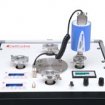 Add My Company
Add My Company
Sign In

Many processes handle vapours and, if any condensation or deposition happens, the chances are it will also happen in the vacuum gauge. Many such gauges - Pirani, cold cathose and ion gauges - use thermal or ionisation cross-section measurements to infer the level of vacuum being experienced and they have filaments,
Even more rugged gauges such as capacitance manometers will be affected by depositions or particulates because any deposition will have mass and the gauge will weigh it, especially if it has a low range and therefore a very thin diaphragm.
As processes move away from their design parameter due to gauge “drift”, little about the quality of the process can be inferred from the instrumentation readings, so diagnosis is down to a skilled operator recognising when a batch of product does not conform.
This is too late! If the process is sensitive to the level of vacuum being achieved, then the cost of losing a batch could be astronomical - many times the cost of maintaining the plant properly in many cases.
With the inherent lack of ruggedness of many vacuum gauges, it is imperative that plant gauges are regularly calibrated and that the operator has spare, calibrated gauges ready to substitute as soon as he fears the process may have drifted away from specification.
The difficulties of calibrating vacuum in-situ
Unfortunately, it is very difficult to carry out in-situ vacuum calibrations due to the amount of hardware needed to establish a suitable level of vacuum in a situation where a calibration standard gauge may be compared. Not the least of concerns is the possible cross-contamination of the standard by a contaminated sensor under test. Another is the difficulty of access to many on-plant gauges. So it has become tradition for gauges to be removed regularly from the plant and shipped to an external calibration laboratory for re-calibration and, in many cases, adjustment to compensate for the effects of contamination.
CalCube showing its useful vacuum coupling storage
With the development of Chell's on-site UKAS calibration service, they have developed CalCube both as a portable vacuum calibration system with which to offer an on-site service but, for customers who would prefer their own facility, a convenient, tried and tested system.
CalCube complies with BS ISO3567:2011 which specifically covers the design and use of vacuum calibration systems and incorporates an ISO/Dis stainless steel calibration chamber with geometry optimised to ensure that all gauges connected see the same level of vacuum so that comparisons may be made.
The development of a technique
Having its own ISO IEC 17025:2005 accredited UKAS laboratory with the lowest uncertainties for Vacuum in the UK, Chell are well placed to prepare CalCube for on-site gauge calibrations. The Transfer Standards fitted to CalCube are calibrated in the laboratory both before and after an on-site calibration job so that the confidence level of the calibration is the highest possible.
CalCube comparing two manufacturer's Capacitance Manometers
CalCube is constructed within a rugged, wheeled flight-case type enclosure having just a 13A mains plug yet containing dry diaphragm backing and turbomolecular pumps with high vacuum isolation valves. Over 40 year's experience of calibrating vacuum gauges have gone into CalCube's design, which includes such capabilities as calibrating both rising and falling pressures very accurately using a pair of ultra-fine Chell CMF valves.
Fitting easily into almost any estate car, CalCube comes with lifting handles to aid safe removal from a vehicle or lifting up steps, etc. A removable side panel is foam lined with cut-outs to hold all the common mating vacuum connector systems - of course, custom connectors may be purchased and housed for specific applications.
Choice of vacuum Transfer Standards will be an important decision, which is aided by Chell's years of experience. These standards, when not fitted to CalCube are housed in another, matching flight-case, ready for convenient return to Chell's calibration lab. for scheduled UKAS calibration. Chell's in-house vacuum standards consist of three high-accuracy capacitance manometers having 20 years of continuous calibration history at national Standard level and these are monitored on a daily basis by a Spinning Rotor Gauge whose ball-flange assembly is also calibrated annually at National Standard level. At the atmospheric pressure end of the scale, the vacuum straight line generated by the capacitance manometers is calibrated against our 32” Schwien Merco-Master manometer giving us the lowest uncertainties in that pressure regime.
Chell's customers thus enjoy the accumulated vacuum calibration skills of over 40 years and, should they have specific different requirements, Chell has the skills to customise CalCube to suit.
For more information on CalCube Conveniently Calibrates Plant Vacuum Gauges talk to Chell Instruments Ltd
Enquire Now
List your company on FindTheNeedle.

